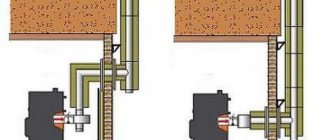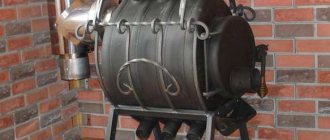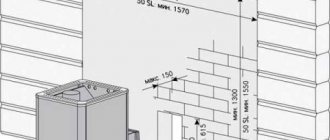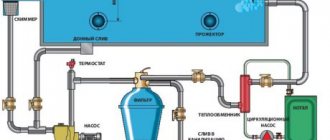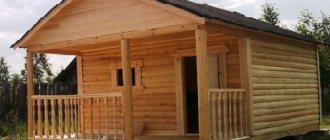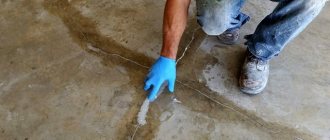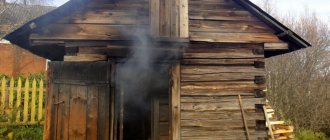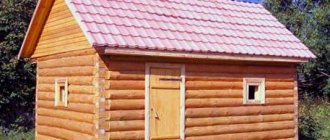The safe use of a stove in a bathhouse, a solid fuel boiler, or a fireplace directly depends on the cleanliness of the smoke ducts. Weak draft during combustion, puffs of smoke that do not come out through the chimney but enter the room are alarming signs that the chimney needs to be cleaned urgently. You can do this yourself using available tools. It will be easier for owners who do not want to deal with soot to invite a chimney sweep.
Users often search for:
- Construction of a metal sauna stove
- Laying a brick sauna stove
Why does the chimney become clogged?
If you don’t delve into physical terms, the appearance of soot can be explained simply: the fuel does not burn completely, and combustion waste simply settles on the walls of the pipe.
This is a natural process, since even in the best stove the fuel does not burn completely. There are three main reasons for a quickly clogged chimney:
- Poor quality fuel;
- Burning garbage in a stove;
- Insufficient traction.
https://www.youtube.com/watch?v=cJovP9aadVs
The rate of clogging of the chimney pipe in a private house depends on the quality of the fuel itself. After all, damp wood burns much worse, and the smoke contains much more carbon dioxide, which forms soot. Therefore, with such fuel it is worth considering that the pipe will have to be cleaned much earlier than when heating with dry wood.
Therefore, if you want the traction not to deteriorate over time, you should monitor the quality of the fuel as much as possible, if possible. Indeed, in most cases, owners simply do not pay attention to the quality of firewood or coal, choosing cheaper options rather than better ones, since any fuel is primarily an expense.
Plastic bottles and bags, pieces of plywood or firewood with paint, remnants of old furniture and many other wastes that are often burned lead to accelerated clogging of the chimney pipe. Even in the firebox after using such fuel you will find much more ash, solid unburnt residues. And in the chimney pipe, the oxide will settle much more actively.
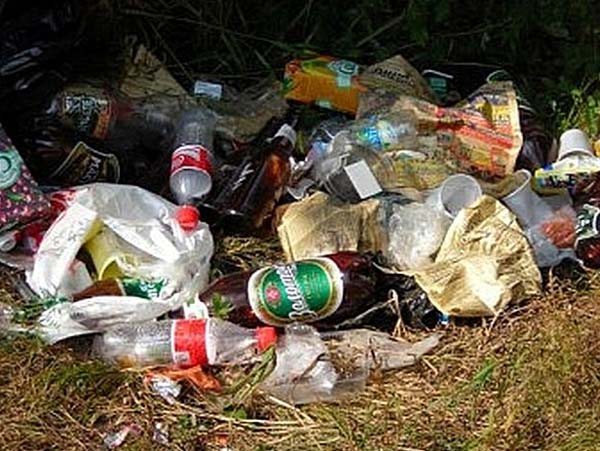
You should never burn garbage in your home stove.
Insufficient traction
The third and most common cause of chimney blockage is insufficient draft. There may be several reasons for this. The first is insufficient air supply to the firebox, when the firewood is simply left to smolder. Of course, this approach allows significant savings on fuel, but leads to contamination of the pipe walls.
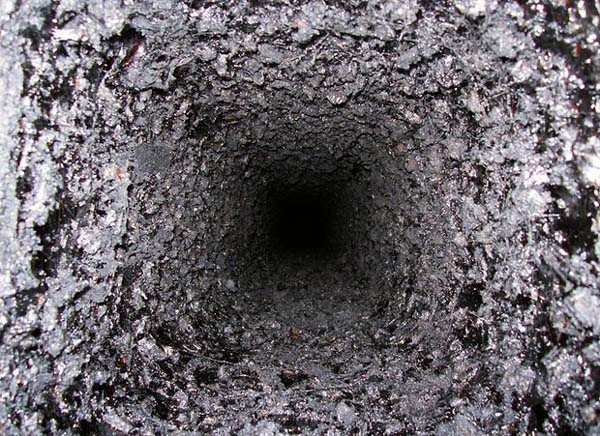
Pipe with layers of soot on the walls
Regardless of the cause of the blockage, you should choose the most suitable method for yourself on how to clean the chimney, because the presence of soot will lead to the fact that the stove or fireplace is guaranteed to smoke, and this will lead not only to discomfort, but also to the danger of fumes entering the room.
How to clean a chimney from soot with your own hands: proven methods
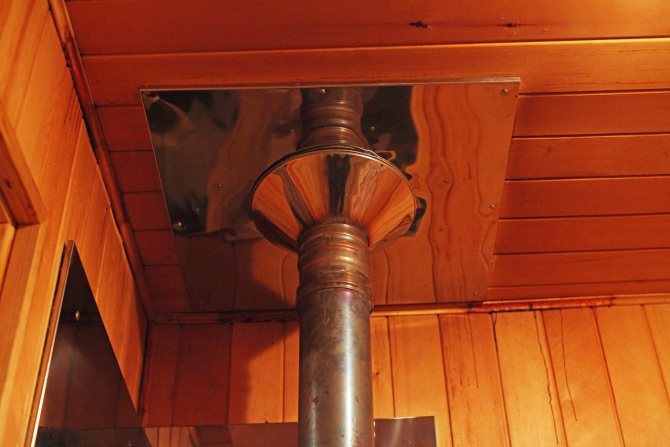
Cleaning the pipe from soot is done mainly in order to restore the draft, which has decreased due to the narrowing of the pipe cross-section due to the accumulation of a thick layer of soot on its walls.
The efficient operation of a fireplace or stove directly depends on the condition of the chimney, its serviceability and cleanliness. Every homeowner should know how to clean a chimney, even if they have a service contract with a service organization.
It's time to clean the chimney
Experts believe that a properly designed and equipped chimney can remain clean for many years, provided that the heating device is used carefully.
That is, if you heat the stove with dry wood without a high tar content, regularly clean the ash pan from ash, and do not burn household waste, then you will only need a light cleaning of the chimney, which consists of removing soot from the cleaning holes located in the room.
But even with the most careful handling, it is necessary to carry out an inspection twice a year to ensure that it is in good condition. After all, cleaning the chimney may be required not only from soot, but also from debris that has flown in from outside, cobwebs, bird nests, etc. As for how to clean the chimney, this problem should be solved as it becomes overgrown with soot, products of incomplete combustion of firewood , other fuel, clogging.
Lighting up a stove or fireplace can be marred by a lack of draft, and the most common cause of this trouble is clogging of the chimney with products of incomplete combustion of wood, simply soot. Without proper chimney cleaning, the operation of the heating device is dangerous for your life, since the smoke simply will not have time to be removed through the system and will begin to accumulate in living quarters! So how to clean a chimney and is it necessary to resort to the help of professional stove-makers and chimney sweeps? Read about it in our article.
Cleaning the chimney with a brush
The content of the article
When the logs crackle merrily in the fireplace, it seems to us that they are completely burned, leaving behind only a handful of ash in the firebox and carrying light smoke into the chimney. But this is far from true: the combustion conditions in the stove and fireplace do not allow the wood to burn out completely, and soot is carried up the chimney along with the smoke. It is gray or black in color and is similar in composition to coal. Soot particles settle on the pipe walls, especially at bends, forming a thick layer of loose deposits.
Plaque formed on the walls of the chimney
When using coniferous firewood, in addition, water vapor and resin are released, which firmly bind the soot into a hard crust. The lumen of the pipe gradually narrows, the draft deteriorates, and the soot layer becomes thicker. Sooner or later the draft disappears completely, and this condition requires immediate cleaning of the chimney.
There are several ways to clean a chimney:
- mechanical, using a brush;
- chemical, using special tablets or liquids;
- preventive, using traditional or modern combustion catalysts.
Which method is right for you will become clear upon further reading of the article.
Mechanical cleaning involves removing soot using a metal brush, which is inserted into the chimney and, making rotational and translational movements, scrapes off the soot from the surface of the chimney. The method has several advantages: it is effective against blockages and solid deposits, it is cheap and quite simple, and does not require special knowledge and skills. At the same time, manually cleaning a chimney through a pipe is a rather dangerous task, because you will have to climb onto the roof.
Heating in a private home is a vital system, on which not only comfortable living, but often the property and life of the residents depends. A special role is played here by the system for removing fuel combustion products from the room - the chimney. Its internal surface gradually becomes contaminated with condensate and soot, while the cross-section of the chimney channel decreases, draft decreases, and the complete removal of smoke from the room is disrupted.
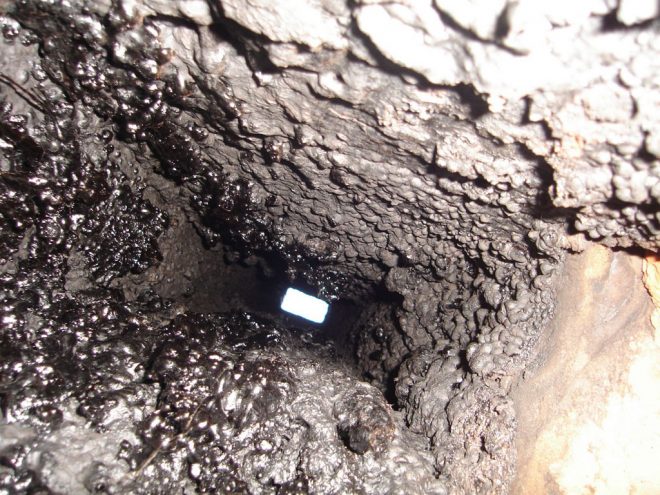
Over time, the chimney becomes clogged with soot, and its ability to remove combustion products decreases.
The purpose of this operation is to timely clean the walls of soot deposits and debris that has gotten inside (during the off-season period). When cleaning, you need to check all sections of the chimney and the stove itself. The last step is to clean the ash pan and firebox. Timely cleaning of the chimney reduces fuel consumption and makes the operation of the stove safe.
In practice, three main cleaning methods are used, two of which are preventive:
- Chemical and biological methods. They are used as a preventive measure using compounds that soften soot and lead to its partial removal from the smoke duct.
- Mechanical. It is carried out by direct impact on the soot layer with various tools in order to remove it.
If you use such products correctly and in a timely manner, you can avoid involving a third-party specialist in cleaning the chimney.
All biological methods are based on adding some substances to a burning firebox. Among the common products you can consider the following:
- potato peelings. This is an old folk remedy for preventing the formation of soot deposits, the simplest and always available. The peels need to be prepared in advance, accumulating at least half a bucket. It needs to be dried and added to the firebox at the end of the fire. When burning, potatoes release starch, which softens the soot layer well. It happens that it simply falls down in layers or pieces, part of it is carried away along with the furnace gases. This operation is also recommended to be performed before performing mechanical cleaning;
- rock salt. The method is used when igniting the stove. The compound formed when the salt is heated softens the soot layer well. A tablespoon of salt should be poured on top of the fuel;
- aspen firewood. Firewood made from this type of wood has a high calorific value, so it is placed at the end of the firebox. Hot furnace gases simply burn soot directly on the walls of the chimney. The danger of this method is that large layers of soot during combustion at high temperatures can destroy the chimney and cause a serious fire. Therefore, this method should be used regularly, laying aspen firewood in small portions. For the same purpose, you can use birch firewood cleared of bark;
- walnut shells. The use of this product is also associated with a high combustion temperature. Therefore, they can serve as an alternative to aspen firewood. But the shells can be used in quantities of no more than two liters at a time. Otherwise, the chimney may overheat with predictable consequences.
Features of pipe cleaning
Depending on the material from which the chimney is assembled (stainless steel, brick), the set of tools and methods for removing blockages may vary.
Stainless steel
Stainless steel chimneys are popular in private homes. They are installed quickly, are resistant to corrosion, and have a long service life.
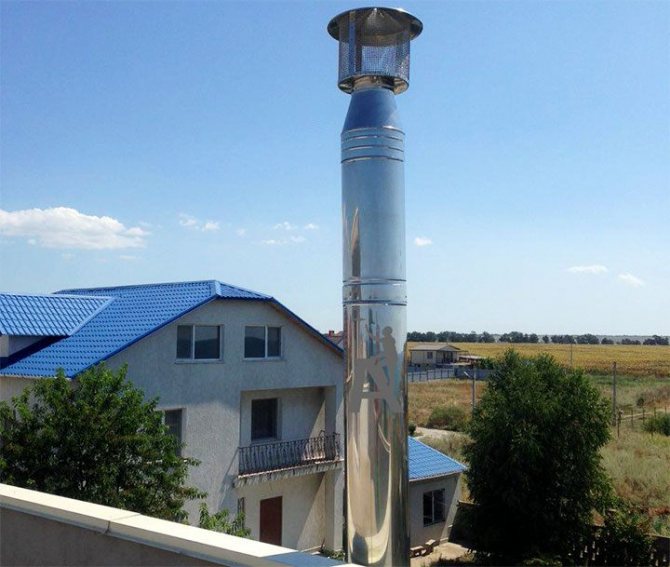
Condensation does not accumulate inside, but flows down the walls into a special collection tank. Soot formation is minimal, but soot may stick inside.
Cleaning takes place in the following sequence:
- A round brush is inserted through the hole in the chimney tee on a flexible handle. The attachment is connected to an electric drill. The dirt is cleared as the brush rotates. To clean the entire height of the pipe, you will have to add a handle along the length.
- Old stubborn stains can be removed using a blowtorch. The chimney will have to be disassembled. Each part must be burned with fire. Operating temperature - 800-900 degrees.
- When the cleaning is completed, it is recommended to insulate the pipe riser to get rid of the dew point.
When purchasing stainless steel pipes, you need to pay attention to the quality of the metal elements. The best option is austenitic steel. It’s easy to check the quality - good steel is not magnetic.
Made from stainless steel sandwich pipes
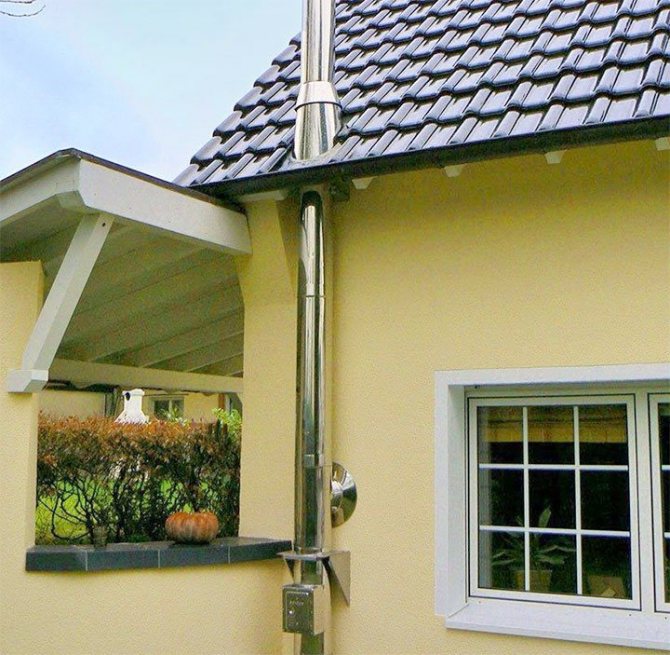
If the sandwich chimney is used correctly, it can be cleaned infrequently. First you need to disassemble it. Contamination will have to be removed with a fine bristle brush - it will not damage the surface. The principle is the same as for a stainless steel chimney.
Made of brick
A brick chimney with a rectangular cross-section is cleaned with a metal brush or brush.
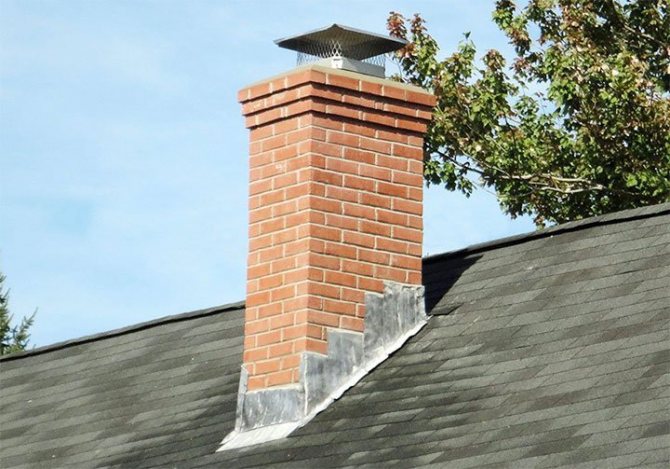
Cleaning looks like this:
- Cleaning of the stove and pyrolysis boiler is carried out with the firebox door closed. If you don't pay attention, a layer of soot will settle throughout the room.
- Before starting work, you need to put on safety glasses, a respirator, and gloves. For multi-storey buildings, a safety rope is required. It would be good to wear a rubberized suit.
- You will have to climb onto the roof and clean from above. You can push soot into the room from below by opening the valves and cleaning doors. A fireplace brush and vacuum cleaner will come in handy.
- The brush is attached to the cable on the handle (the length can be increased). It goes down the pipe.
- If the soot layer is thick, it must first be removed with a scraper.
- When the soot in the pipe has already coked (turned into solid pieces), a heavy steel ball is taken and suspended on a cable. A diameter of 85 mm will do. You can also take a larger diameter. The main thing is that the core blocks the passage by ⅔.
- It is prohibited to use dumbbells and weights. There is a big risk that it will get stuck inside the smoke channel.
For convenience, the ruff is attached to a rubber hose, steel cable, or strong rope. To connect the elements, use carabiners and wire.
Methods for cleaning a chimney
Since chimney cleaning is a procedure that all owners of solid fuel heating devices must go through, there are quite a few ways to do it. In fact, cleaning chimney pipes near stoves and fireplaces is divided into three types:
- Chemical;
- Mechanical;
- Traditional methods.
Therefore, there is a choice of how to clean your chimney from soot, with minimal time, effort and money. Therefore, before making a final decision on how to clean the chimney, you should familiarize yourself with all possible cleaning methods.
For most stove owners, it is preferable to clean chimneys with your own hands, since this is what allows you to not only save money, but also carry out this procedure at any convenient time. But at home, quite often there may not be enough materials to clean the pipe or soot, since the process itself depends on what you use to carry it out.
Therefore, in order to avoid problems when cleaning the chimney from soot, you should consider not only all available options, but also the conditions in which you will have to carry out the work. In addition, it is worth taking into account such additional factors as clogging, accessibility on one side or the other of the pipe, the material and stability of the chimney itself, as well as the stove itself, because for each private home these parameters are individual, naturally, cleaning products must be selected individually.
How not to clean a chimney
When cleaning, the following points should not occur:
- Open flap of the firebox, cleaning valves. Before the procedure, all holes are tightly closed, otherwise you will then have to wash all the walls and furniture from soot.
- In fireplaces and sauna stoves where there is no firebox door, the opening should be covered with a damp cloth.
- Hot oven during mechanical cleaning. According to fire safety guidelines, soot from the chimney should only be removed when the stove has cooled down.
- Wind, heavy rain, snow. Under such conditions, it is dangerous to climb onto the roof to remove soot from the chimney. It is easier to clean from the inside of the room.
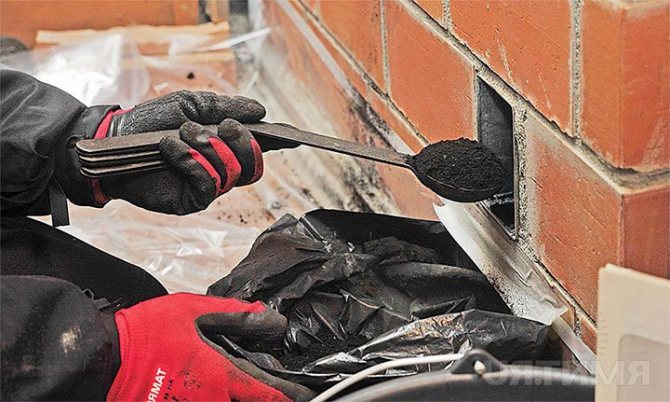
Without experience, it is prohibited to disassemble wall and other parts of the chimney. Improper reassembly may cause a fire in the future.
Why does the chimney become dirty?
Clogging of the smoke channel occurs during the combustion of fuel, when vapor and solid products are released from it and carried away by the flow of furnace gases. But under certain conditions they do not fly out completely into the chimney. This happens under the following circumstances:
- Burning wet wood. Fuel with a moisture content above 24% contains an increased amount of intracellular moisture, which actively evaporates as it burns. These vapors rise along with the stove gases into the chimney. In a cold or insufficiently heated channel, they mix with cooled air, as a result of which condensation settles on its walls. And this is not just water, because the vapor contains oxidation products, so the sediment is acids. They do not just flow down the walls of the pipe, a significant part of them lingers on the walls, depositing solid combustion products from the smoke, and carbon deposits form on the walls, reducing the cross-section of the smoke channel.
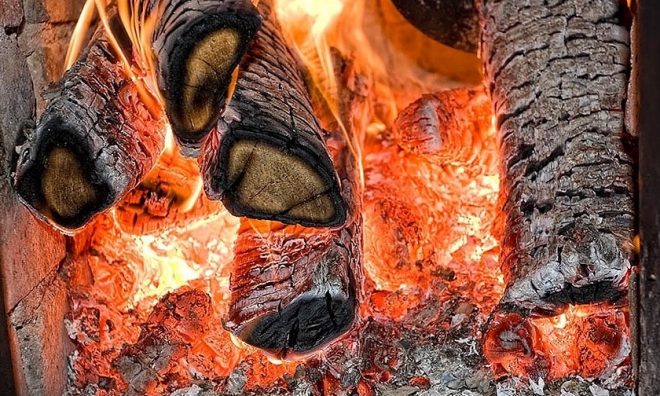
When raw wood burns, it releases excess moisture, which ultimately settles on the walls of the chimney and becomes a source of soot. - Use of prohibited fuel. Of course, there are no direct contraindications, but wood processing waste, consisting of wood with fillers in the form of binders, cannot be used to fire the stove. Such materials include waste plywood, chipboard and fiberboard. Such fuel releases a large amount of tar in the smoke, which intensively settles on the walls of the chimney. Resinous wood - pine or spruce - also has a similar effect.
- Cold chimney. Moisture condensation on the walls occurs at a certain temperature in the channel. This state of gases is called the “dew point”. If such conditions are created inside the smoke channel, condensation settles on its walls in an active mode, provoking the accumulation of soot. To get rid of this phenomenon, you need to reliably insulate the pipe, reducing its heat transfer into the surrounding space. After this, the chimney will warm up, and the dew point will rise higher, leaving the space inside the pipe.
- Presence of horizontal pipe sections. The largest amount of soot forms on the bends of the chimney, so it is better not to use this installation method unless absolutely necessary. If another solution is not possible, cleanouts must be installed on the rotary elbows, which can be opened and free the elbow from soot deposits.
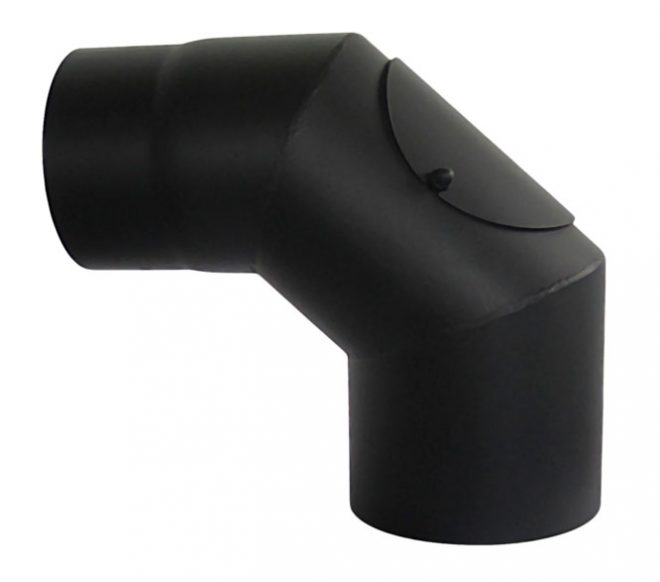
If you need to make a horizontal section on the chimney, the transition to it must be done using an outlet with a special hole for cleaning (revision) - Rough walls of the smoke channel. When constructing a chimney, it is necessary to mop the channel to improve the quality of its surface. Soot is deposited primarily on the uneven surfaces of the chimney.
- Fire the stove with household waste. Such fuel is even more destructive to the chimney than the use of plywood and other scraps. It always contains remnants of plastic or polyethylene packaging, which release a lot of chemicals when burned. In this case, the chimney is guaranteed to become overgrown with soot faster than the heating season ends.
Why and how often should you clean your oven?
Smoke ducts must be cleaned before and after the heating season. Small stove structures, where the smoke channels run at an angle, will become clogged more often, so they are cleaned even in winter.
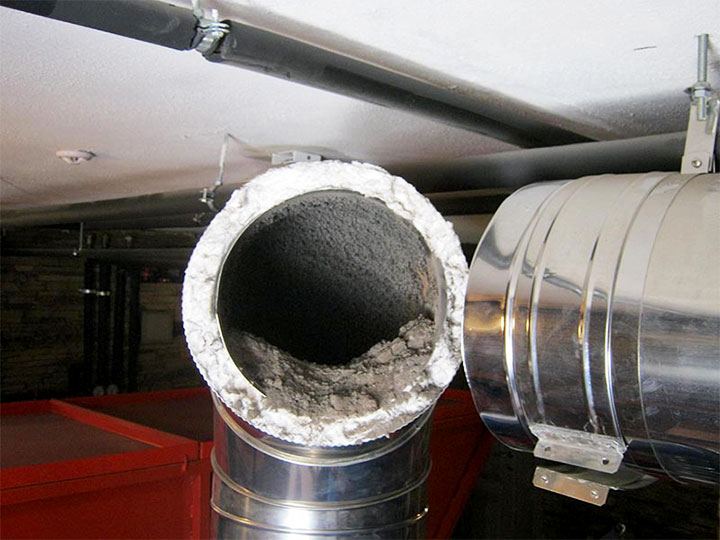
It is better if the chimney pipe runs vertically, without horizontal sections or many turns. Soot and various accumulations will immediately rise up through the pipe.
It is convenient to install cleaners in the form of tees at turns.
Timely cleaning of the chimney guarantees the safe operation of the stove and the entire fireplace structure, extending their service life, protecting residents from carbon monoxide poisoning and harmful substances that enter the air.
Methods for cleaning a chimney
The easiest way to clean a chimney is to use chemicals that are simply thrown into the firebox. There are quite a few chimney soot cleaners, they may differ in manufacturer and release form, but they have one rather significant drawback.
A soot chimney cleaner helps only in the early stages of blockage; if the layer of scale on the walls is more than a few millimeters, then such products are ineffective. In fact, to combat soot, chemical cleaning of the chimney pipe from soot is used only as a preventive measure. Therefore, if the thickness of the soot layer in the chimney is significant, then you will have to resort to other methods.
Log chimney sweep
Almost any chimney cleaner works according to the following scheme. You place a box or log to clean the chimney into the melted firebox, after which, when burned, they release active substances that volatilize soot. It is easiest to use logs, since they easily fit into the firebox, do not require special conditions, and, moreover, are inexpensive in most cases. Chimney cleaning tablets have the same effect, but it is worth considering that they also have a rather limited spectrum of action.
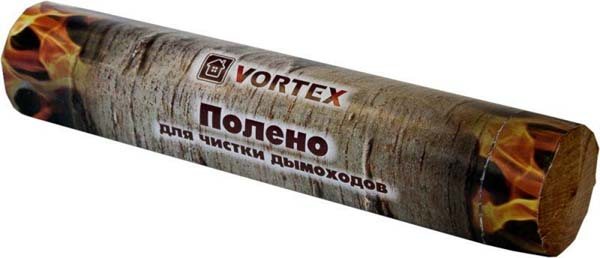
Log chimney sweep
Chemical cleaning is a means of prevention, so if you want to avoid labor-intensive work, you can use it from time to time. After all, no matter what kind of firewood you use, you cannot avoid chimney cleaning without preventive measures.
Since cleaning the chimney is mandatory, if you want the stove to burn well and be safe, then in case of severe contamination, a mechanical method of removing soot is best suited. Of all the possible methods, mechanical manual cleaning is the most reliable option, which guarantees complete removal of soot from the chimney.
What type of wood cleans the chimney when burned?
As practice has shown, aspen, alder and hornbeam firewood is not only excellent for cooking barbecue and smoking outdoors, but also acts as a natural cleaner of smoke ducts from soot deposits. When burned, they do not release resin or tar and promote peeling of soot from the pipe walls.
We recommend reading the article: “How to make a wood splitter.”
Alder
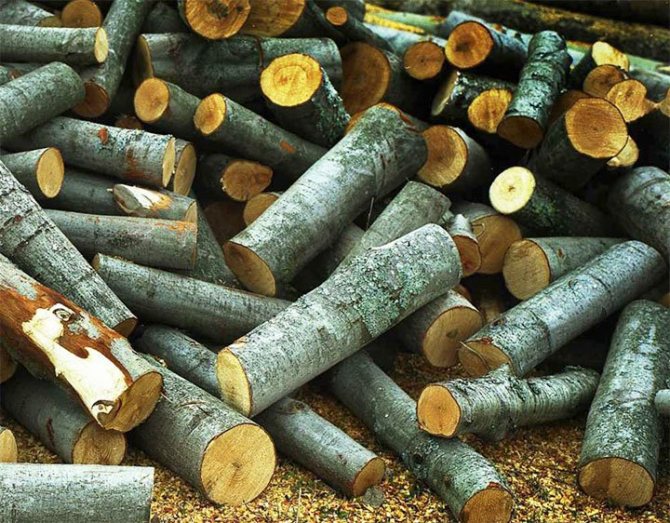
Alder firewood is called royal wood because when burned it produces a pleasant aroma, good heat, does not smoke, and helps soften soot.
Aspen
Dry aspen logs are used for cleaning. They are thrown into the firebox at the end and quickly burn out, burning all the soot on the inner walls of the chimney pipe.
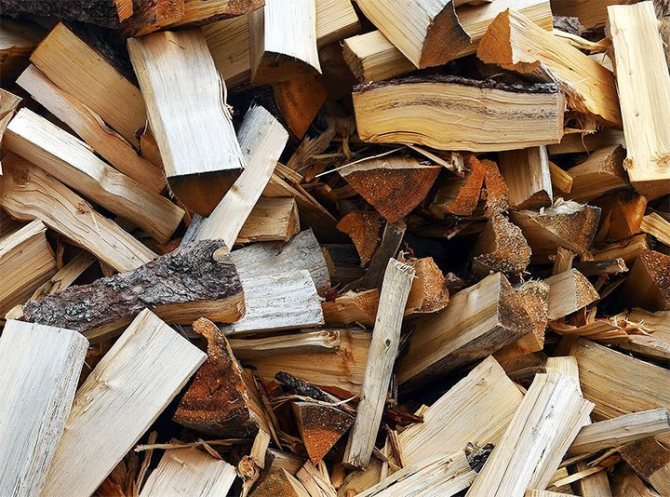
It is recommended to protect the top of the pipe with a deflector so that flying sparks do not cause a fire.
They are rarely used as the main fuel due to the combustion rate and low heat transfer.
Hornbeam
Stove owners may be interested in hornbeam firewood. There are two good reasons for this:
- No smoke when burning.
- High heat transfer during combustion.
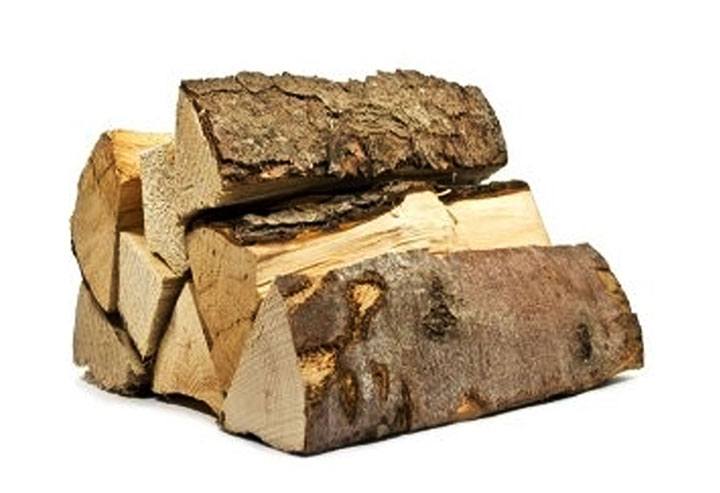
They are also used as the main fuel, preventing soot from forming on the walls.
Signs of a clogged chimney
When the flue gas exhaust channel becomes clogged, it will be immediately visible. The main signs of a clogged channel will be the following:
- Deterioration of draft in the stove or fireplace. You need to check the gate, and if it is in the open position, it means that the pipe is overdue for cleaning.
- Gradual attenuation of the flame in the furnace of a heating unit.
- Difficult fuel combustion. If you use dry wood and it doesn't burn, the chimney is most likely to blame.
- Changing the color of the flame in the firebox. You should be especially wary if it has acquired an orange color.
- Strong unpleasant odor. If acrid smoke appears in the room during the combustion process, it means that carbon monoxide (carbon monoxide) is entering it. In this case, the room should be well ventilated, the firebox should be interrupted and measures should be taken to clean the chimney.
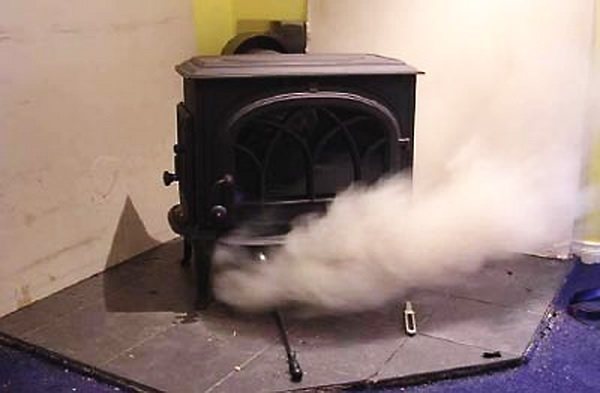
The appearance of smoke when the gate is open indicates a lack of draft
Before the start of the heating season, you must inspect the inside of the chimney for blockages. In the warm season, birds with a nest may settle in it, or debris may appear, blown into the pipe by the wind. To avoid this, the chimney must be equipped at the installation stage with a cap with a mesh that prevents such situations.
In such a case, the house should always have a backup heating unit in the form of a heater or an electric heater built into the heating system.
Having provided yourself with warmth with its help during the cold season, you can carefully consider the situation and think through options for getting out of it.
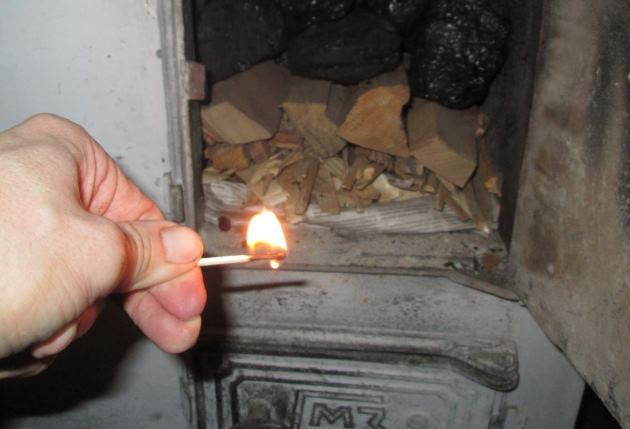
The presence of draft in the firebox must be checked every time the stove is ignited - the flame must deviate towards the chimney
Folk remedies
Since stove heating has been used for centuries, there are many options for how to clean soot from a chimney using folk remedies. Many of them are quite effective, especially for prevention purposes.
Aspen firewood
The best way to clean soot from chimneys is aspen firewood, especially in the early stages of contamination. Despite the fact that aspen cannot be called a high-quality fuel, when burned it releases substances that help get rid of soot, so this product is quite effective. If you have a small supply of aspen firewood at home, then using it periodically will allow you to clean the chimney without making any effort.
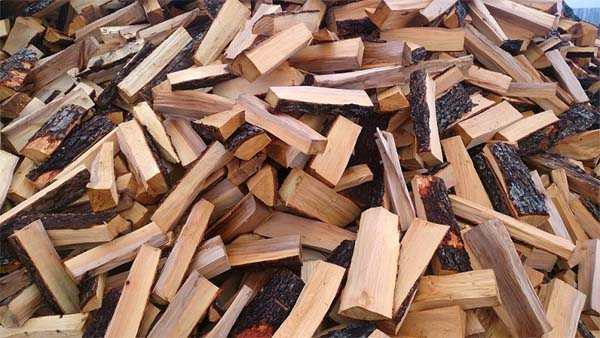
Aspen firewood
Potato peeling
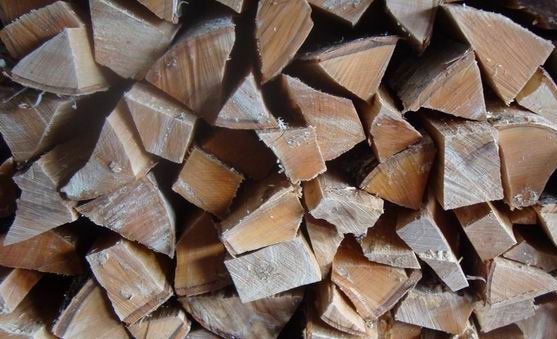
Another proven folk remedy is dried potato peelings. Cleaning a chimney from soot using this folk method is very simple, and such methods have been used for a very long time, and they have proven their effectiveness. Dried cleanings are simply poured into the firebox; when burned, they also release substances that peel off oxide deposits on the walls. It is also worth considering that after prevention with potato peelings, soot can fly out of the chimney for two to three days.
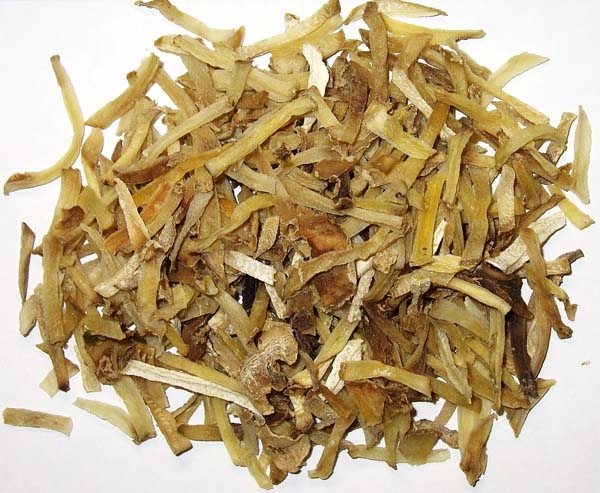
Folk method - burning potato peelings in an oven
Salt
If you are faced with the question of how to clean a metal chimney, then it is worth remembering such a common remedy as simple salt. You can even clean a stainless steel chimney with salt, as this is also one of the best and most affordable means. Salt is also simply poured into the firebox; when heated, sodium chloride reacts with carbon dioxide, as a result of which the soot simply flakes off. But it is worth remembering that pieces of soot can simply flake off and fall down, so the chimney mouth must be checked and cleaned periodically.
In addition, modern folk remedies have appeared on how to clean a chimney from soot, compiled by folk craftsmen, they are also effective, but in some cases they are unsafe, so we will not mention them. Do not carry out experiments, since if soot accumulates in a large amount in the chimney, it can simply ignite and, in the worst case, explode. Therefore, choose carefully how to clean the chimney so as not to damage the stove or the chimney itself.
Remember, a chimney that you periodically clean will be guaranteed to keep your home comfortable and safe.
The chimney sweep is a slightly mysterious and fairy-tale character. However, in reality he is not “clean and sweet”, as he was next to the shepherdess of the brilliant Andersen. Life has corrected that slight misunderstanding that the author of the famous fairy tale noticed, and has made the specialist in this field not only “crazy,” but also not at all fragile.
Chimney cleaning is a serious undertaking necessary for the normal operation of any fireplace, boiler or stove. And it's not just about cleanliness and order. During the combustion process, various chemical compounds are released, some of which settle on the walls of the chimney, gradually reducing its lumen area. If this area falls below a critical value, the heater will not be able to operate normally.
A thick layer of soot prevents the pipe from warming up, which reduces draft, and poor draft is dangerous because CO (carbon monoxide) will begin to enter the room, which is toxic to humans and can lead to tragic consequences. Also, soot contains oily compounds that were not burned in the firebox, which can ignite at a certain temperature.
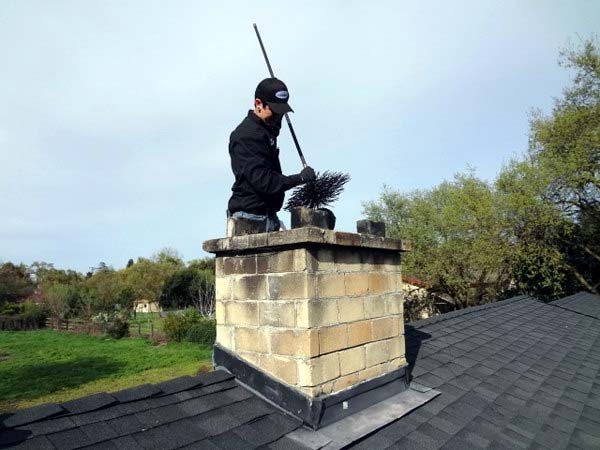
The problem of cleaning chimneys has existed for a long time, and accordingly, there are traditional and modern methods. Although mechanical cleaning can be classified into both categories, since it was used in ancient times and remains relevant today.
Deposits in the chimney pipe can cause it to break.
Choosing firewood and cleaning the chimney are important aspects of operating a fireplace and stove
1. Optimal choice of firewood
2. Chimney cleaning: rules and secrets
3. How to determine if your chimney needs cleaning
Do we think about what kind of firewood is best to use to light a fireplace , home or sauna stove? In most cases, unfortunately, no. We choose whatever comes to hand first in the store, or we prepare it ourselves from trees that grow near the house. And this is not entirely correct.
When using wood heating appliances, the choice of firewood is of great importance. This determines not only the efficiency, but also how often the chimney will have to be cleaned. We will tell you about all this in this article.
Optimal choice of firewood
First, it’s worth determining what qualities good firewood should have. First of all, when burning they must release the maximum amount of heat. Secondly, you should consider the cost: some types of wood are so expensive that sometimes it is better to find a cheaper alternative.
Finally, it is important to understand the characteristics of each type of wood. After all, some give a wonderful aroma, others give a beautiful flame, and there are also those that leave a large layer of resin and burning in the chimney.
We offer some simple tips that will allow you not to make mistakes when choosing firewood.
The most common types of wood used for lighting stoves and fireplaces are:
- Poplar,
- Aspen,
- Birch,
- Ash,
- Pine.
The main advantage of poplar firewood is its cost. But even this “plus” will not cover the main disadvantage of such wood: a small amount of heat. The logs burn out very quickly and leave almost no coals.
Aspen is good not only for the firebox, as it burns well, smells nice and gives enough heat, but also for cleaning the chimney. Unfortunately, such wood is more expensive than other species and is not often on sale.
Birch firewood burns for a long time, gives good heat, but at the same time smokes quite strongly. Therefore, it is better not to use them in open-type heating equipment.
The main advantage of ash firewood is that it can be burned even in its raw form: it will not only burn well, but also give good heat.
And perhaps the best option is pine. It burns well, has high heat transfer, and has a pleasant aroma. But, like many other coniferous trees, pine contains resin, so you will have to clean both the chimney and the stove or fireplace a little more often.
Chimney cleaning: rules and secrets
80% of buyers select the wrong equipment. Leave a request for a FREE selection of a fireplace, stove, chimney taking into account all your parameters/needs. You will receive advice from a specialist who has been working in the furnace business for 15 years. AND 500 RUBLES AS A FREE!
No matter how great the firewood you choose is, you will still have to clean your chimney. This procedure is necessary in order to remove soot accumulated on the walls. Otherwise, it is possible not only to reduce the efficiency of the fireplace or stove, but also to ignite the accumulated combustion products.
Of course, chimney sweeps are the best ones to handle this. But are there ways to carry out prevention so as not to resort to their services very often? Of course have.
Traditional methods:
Proven means for preventing soot accumulation are salt and potato peelings. They are placed in the firebox, directly on top of the firewood. The released substances soften the soot, and it comes out along with the combustion products.
As we wrote above, aspen firewood is suitable for cleaning a chimney: it heats the walls of the chimney to high temperatures, and the soot begins to burn out.
Chemical compositions:
The modern market offers a large number of special products that help carry out preventive cleaning of the chimney. During combustion they are simply added to the fuel. Such compositions emit substances that are harmless to humans, which perfectly clean both the walls of the heating device or sauna stove itself, and the chimney.
Mechanical cleaning:
To do this, you can use specialized brushes, vacuum cleaners, and devices for cleaning the chimney from below. Or you can make a pipe cleaner yourself: cut a plastic bottle in many places from the bottom, and insert a rod into the neck.
How to determine if your chimney needs cleaning
So you've used your fireplace or stove for quite some time. Most likely, you may have experienced the first symptoms of soot accumulation on the walls of the pipe. But, unfortunately, many users know nothing about them.
The first indicator that it's time to call a chimney sweep is dark smoke. When the chimney is clean, the smoke is light, almost white.
The second clue is the flames and sounds when wood burns. If the fire is light and the wood burns quietly, then everything is fine. But when the flame turns dark orange and the wood crackles unnaturally loudly, this is the first sign that you need to call a specialist.
We hope our tips will help you. And, of course, don’t forget to call a chimney sweep. After all, this is not only useful, but also, as the proverb says, meeting a chimney sweep is good luck!
Source: https://www.pech-center.ru/articles/vybiraem-drova
Mechanical cleaning
Some chimney cleaning situations require separate consideration.
The entire process of cleaning a chimney has already been briefly described above. To what has been said, you only need to add that if the smoke channel is severely clogged, the first operation is to punch through the carbon deposits with a core without additional devices. Only after this are brushes of different sizes and designs used sequentially.
When performing work, care should be taken to create safe working conditions.
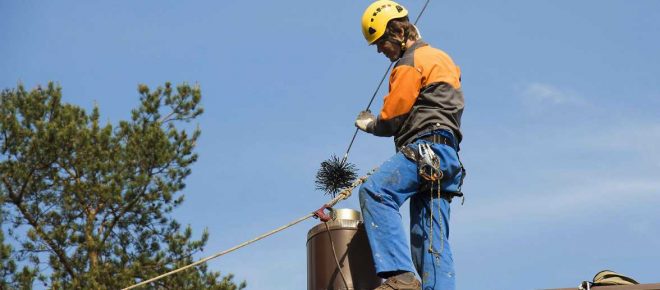
When working at height, be sure to wear a safety rope
Log chimney sweep
Log chimney sweep
Today, many private homes have fireplaces and even wood-burning stoves, and connoisseurs of such relaxation prefer to heat their baths with wood. Gas burners and other technical innovations, of course, make the life of a modern person much easier, but do not create that amazing, unique atmosphere that occurs when using natural fuel. Fortunately, these days you can get any firewood even in a metropolis, so there are practically no problems with organizing such heating.
The only inconvenience is that from time to time it becomes necessary to remove soot from the chimney that has settled on the walls - such deposits impair draft, resulting in reduced performance characteristics of the stove. Today this problem can be solved in different ways. The easiest way is to buy a special powder - prices are affordable, efficiency is high. But if you don’t trust chemicals, then you can use the old-fashioned method of cleaning a chimney with aspen firewood.
